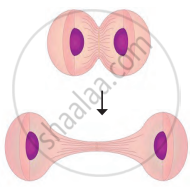Advertisements
Advertisements
Question
With the help of suitable diagrams, explain mitosis in detail.
Solution
Mitosis cell division is completed in two steps.
- Division of nucleus (karyon (nucleus) + kinesis (division) = Karyokinesis)
- Division of cytoplasm (cyto (cytoplasm) + kinesis (division) = cytokinesis))
I. Karyokinesis is further divided into four steps:
(i) Prophase: It is the first stage of mitosis that is marked by the initiation of the condensation of chromosomal material. Each chromosome is composed of two chromatids, which are attached by the centromere. At the end of prophase, the mitotic spindle begins to form from the centrioles. The nuclear membrane and the nucleolus disappear completely by the end of this stage.

(ii) Metaphase: It is the second stage of mitosis in which the condensation of the chromosomal material and the spindle formation gets complete. The spindle fibres get attached to the kinetochores of the chromosomes and the chromosomes get aligned along the metaphase plate in the middle of the nucleus.

(iii) Anaphase: It is the stage of mitosis where the centromere of the chromosomes split and the chromatids get separated. The contraction of the spindle fibres moves the sister chromatid apart, towards the two opposite poles.

(iv) Telophase: It is the last stage of mitosis. In this stage, chromosomes finally reach their respective poles. The spindle fibres disappear and the nuclear envelope reappears around the chromosome cluster. Also, the nucleolus, Golgi complex, endoplasmic reticulum, and other cell organelles re-appear.

II. Cytokinesis:
The cytoplasm divides by cytokinesis and two new cells are formed which are called as daughter cells. In this process, a notch is formed at the equatorial plane of the cell which deepens gradually and thereby two new cells are formed. However, in case of plant cells, instead of the notch, a cell plate is formed exactly along midline of the cell and thus cytokinesis is completed.

Cytokinesis
APPEARS IN
RELATED QUESTIONS
Study the diagram given below which represents a stage during the mitotic cell division and answer the questions that follow

(i) Identify the stage giving suitable reasons.
(ii) Name the parts numbered 1 and 2.
(iii) What is the technical term for the division of nucleus?
(iv) Mention the stage that comes before the stage shown in the diagram. Draw a neat labelled diagram of the stage mentioned.
(v) Which is the cell division that results in half the number of chromosomes in daughter cells?
The given diagram shows a stage during mitotic division in an animal cell

(i) Identify the stage. Give a reason to support your answer.
(ii) Draw a neat labelled diagram of the cell as it would appear in the next stage. Name the stage.
(iii) In what two ways is mitotic division in an animal cell different from the mitotic division in a plant cell?
(iv) Name the type of cell division that occurs during :
A. Growth of a shoot
B. Formation of pollen grains.
Given below is a diagram representing a stage during mitotic cell division. Study it carefully and answer the questions which follow :

(i) Is it a plant cell or an animal cell? Give a reason to support your answer.
(ii) Identify the stage shown.
(iii) Name the stage which follows the one shown here. How is that stage identified?
(iv) How will you differentiate between mitosis and meiosis on the basis of the chromosome number in the daughter cells?
(v) Draw a duplicated chromosome and label its parts.
Choose the best option out of the four alternatives a, b, c and d
In which one of the following options the two stages of mitosis have been given in correct
sequence?
(a) Prophase, anaphase
(b) Metaphase, telophase
(c) Anaphase, telophase
(d) Telophase, anaphase
Imagine one cell (A) has undergone one mitotic division and another cell (B) has completed its meiotic division. How many cells would the two produce?
Cell A: ______
Cell B: ______
Mitosis occurs in our ______ cells.
Distinguish between
Mitosis and meiosis.
Given below is a diagram representing a stage during mitotic cell division. Study it carefully and answer the questions that follow:
(i) Is it a plant cell or an animal cell? Give a reason to support your answer.
(ii) Identify the stage shown.
(iii) Name the stage that follows the one shown here. How is that stage identified?
(iv) How will you differentiate between mitosis and meiosis on the basis of the chromosome number in the daughter cells?
Mention, if the following statement is True or False. If false rewrite the wrong statement in its correct form:
Mitosis results in four daughter cells.
Multiple Choice Question:
Cell division occurring in somatic cells is
___________ cells divide by mitosis.
The first step of karyokinesis is ____________.
_________ is not a part of mitosis.
